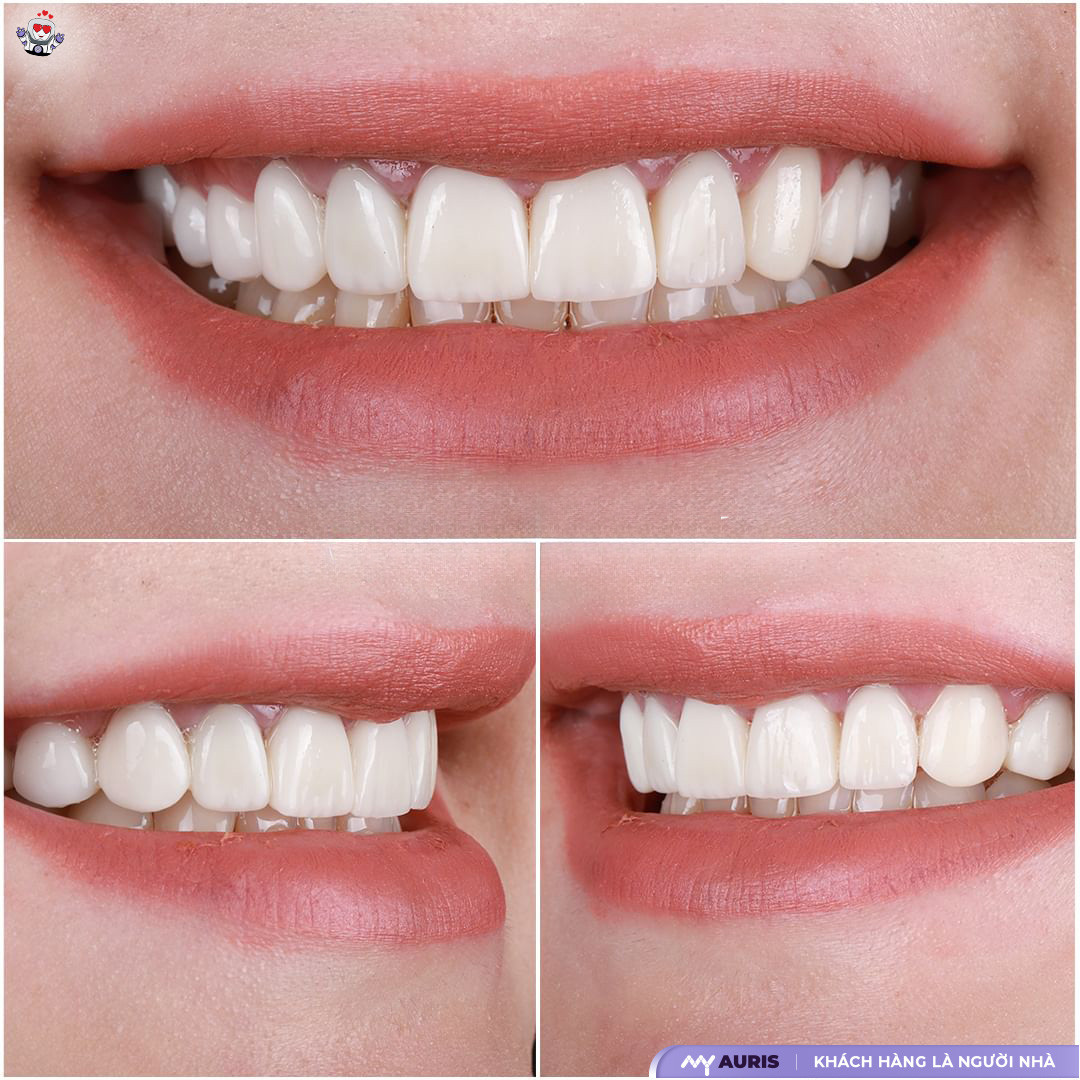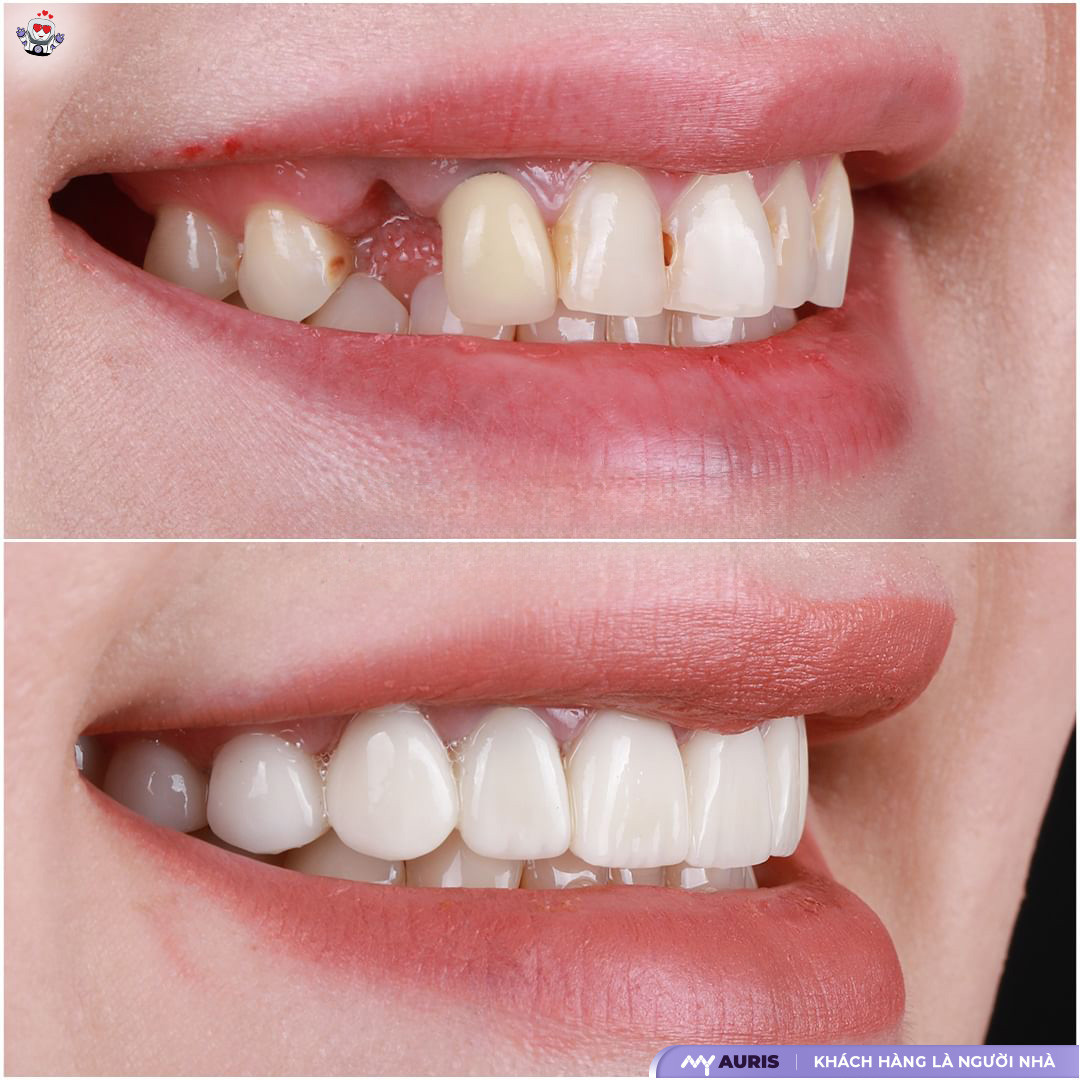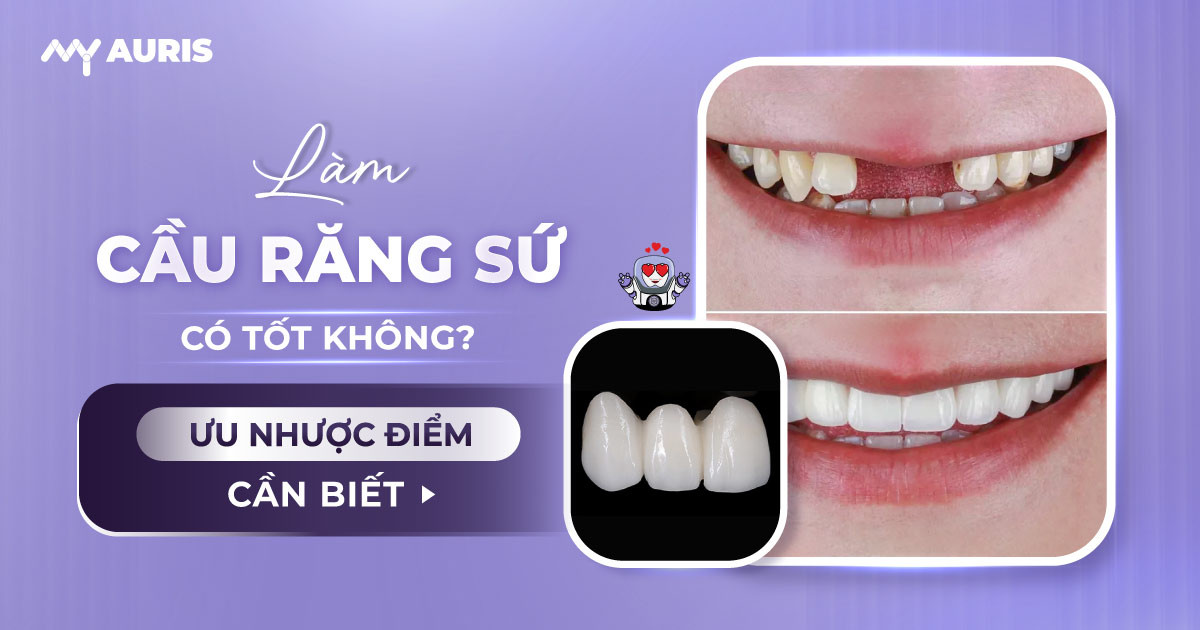Currently, porcelain dental bridges are a popular solution for replacing missing teeth, favored for their quicker procedure time and more reasonable cost compared to dental implants. So, are porcelain dental bridges good? Are they durable? These are common questions for many patients exploring tooth restoration methods. In the article below, My Auris will help you understand more about the porcelain dental bridge method – from its concept, advantages and disadvantages, to the detailed procedure. The latest information will help you make the right and most suitable choice for your oral health.
What is a Porcelain Dental Bridge?
A porcelain dental bridge is a popular method for restoring missing teeth, particularly effective for replacing 1-3 adjacent missing teeth. This method involves grinding down two natural teeth on either side of the missing tooth/teeth to serve as abutment teeth for a series of prosthetic teeth. This series includes a false tooth/teeth in the middle and two porcelain crowns at each end, which are then cemented onto the abutment teeth.
Typically, a porcelain dental bridge consists of 2, 3, or 4 securely connected porcelain crowns. The middle section comprises 1 or 2 false teeth replacing the missing ones. A mandatory requirement is that the natural teeth being prepared (abutment teeth) must be healthy enough to firmly support the dental bridge, ensuring its long-term stability and aesthetic appeal.
A major advantage of porcelain dental bridges is their lower cost compared to dental implants, along with a quicker procedure time, no need for surgery, or bone integration period. This makes it an optimal choice for those who cannot afford implants, or in cases where the adjacent teeth to the missing space are healthy and need to be crowned for protection.

Is a Porcelain Dental Bridge Good?
Advantages of Porcelain Dental Bridges
- High Aesthetic Appeal
Is a porcelain dental bridge good? The answer is yes, especially regarding its high aesthetic appeal. A porcelain dental bridge restores missing teeth with a size, shape, and color similar to natural teeth, providing new teeth that look natural and harmonious with the entire dentition. As a result, patients will feel confident in their daily interactions, no longer worried about missing teeth.
- Quick Procedure Time
Compared to implant placement, which requires 3-6 months for osseointegration, a porcelain dental bridge can be completed in just 2-5 days. From initial examination to completion, only 1-2 visits are needed, allowing patients to quickly achieve a beautifully aligned smile. This is due to the application of modern digital technology and advanced manufacturing techniques, enabling rapid tooth restoration while ensuring quality.
- Quick Restoration of Chewing Function
With the porcelain dental bridge solution, patients can restore chewing ability to approximately 60-70% of natural teeth. The crowns are securely fixed and do not shift during eating and drinking, allowing normal chewing within just a few days. This is a significant advantage of porcelain dental bridges that many people are choosing over other methods.
- Cost-Effective
A more cost-effective tooth restoration option is a porcelain dental bridge, especially compared to dental implants. The price difference comes from the simpler porcelain crowning procedure, which does not require deep surgical intervention and has lower material costs. Therefore, it is an ideal choice for those who want fast, beautiful, and affordable tooth restoration.

Disadvantages of Porcelain Dental Bridges
Although considered one of the common tooth restoration solutions, porcelain dental bridges still have several notable limitations. To make the most suitable choice, you need to understand the disadvantages of porcelain dental bridges from a dental professional’s perspective:
- High rate of natural tooth invasion, affecting adjacent teeth
One of the biggest disadvantages of a porcelain dental bridge is the high rate of natural tooth invasion. Specifically, the teeth adjacent to the missing tooth/teeth must be ground down to serve as abutments for the bridge. This process will wear down the two adjacent teeth, causing them to lose enamel and dentin, weakening the abutment teeth, and even making them loose. In such cases, the bridge cannot be supported, and the dentist will have to grind down other teeth for support, affecting overall oral health.
- Chewing function not guaranteed long-term
A common disadvantage of porcelain dental bridges is that chewing function is not guaranteed long-term. This method can only restore chewing function by about 70%, as dental bridges do not prevent jawbone resorption. Over time, after a few years, the abutment teeth may show signs of gum recession, or even severe gum recession on both abutment teeth, leading to a significant gradual decrease in chewing ability.
- No ability to prevent jawbone resorption
Unlike implants, dental bridges only replace the crown portion of the tooth and fill the gap of the missing tooth/teeth; they have no ability to prevent bone resorption. When the jawbone resorbs, patients can easily experience complications such as malocclusion, gaps between teeth, gum recession, exposure of abutment tooth roots, affecting aesthetics and creating opportunities for bacteria to enter the tooth socket, increasing the risk of infection.
- Limited patient suitability
Not everyone is suitable for a porcelain dental bridge. This method is only effective for replacing one or a few missing teeth, provided that the two abutment teeth are strong and free from oral diseases. Specifically, it is challenging for those missing a #7 molar, as there may not be enough support for the bridge.
- Not applicable for multiple missing teeth
In situations where too many teeth are missing or an entire arch is missing, the abutment teeth may not be strong enough to support the crowns, leading to treatment failure. In such cases, the dentist will recommend a more optimal tooth restoration method, typically dental implants, for long-term effectiveness.
- Short lifespan
Another disadvantage of porcelain dental bridges is their short lifespan, typically lasting only 3-5 years on average. The durability of the bridge depends on many factors such as the abutment preparation technique, the material of the porcelain crown, the health of the abutment teeth, the bite condition, and daily oral hygiene practices. If not properly cared for, the lifespan can be further shortened.
When should a porcelain dental bridge be applied?
The porcelain dental bridge method is a common restoration solution prescribed by dentists for tooth loss, especially when patients are not suitable for dental implants. Below are specific cases where a porcelain dental bridge should be applied:
Loss of 1-3 adjacent teeth, while the natural teeth on either side of the gap are still healthy enough to serve as abutments to support the bridge.
Patients with missing teeth but no jawbone resorption, meaning the jawbone is stable enough to support a porcelain dental bridge without the need for surgery.
Cases requiring rapid restoration of chewing function and aesthetic improvement, especially for teeth located in the smile zone.
Patients who are not healthy enough for surgery or do not wish to undergo dental implant surgery.
Individuals who do not have the financial means to choose the implant method – which is significantly more expensive than a porcelain dental bridge.
Applying a porcelain dental bridge not only helps patients quickly restore aesthetics but also ensures stable chewing ability in a short period. However, to achieve optimal results, patients need to be correctly diagnosed by a dentist and have the procedure performed at a reputable dental clinic with highly skilled doctors and modern technology.
Is a Porcelain Dental Bridge Durable?
A porcelain dental bridge is a durable tooth restoration solution, chosen by many for its high strength and good chewing ability comparable to natural teeth. According to professional experience, the average lifespan of a porcelain dental bridge can be 7-10 years, or even longer if properly cared for.
However, the question “How long does a porcelain dental bridge last?” also depends on factors such as:
The material of the porcelain crown (all-ceramic crowns have higher durability than metal-ceramic crowns),
The condition of the abutment teeth before restoration,
The dentist’s skill,
And especially daily oral hygiene practices after the bridge is placed.
If performed with the correct technique, combined with the use of high-quality porcelain materials and proper post-treatment care, a porcelain dental bridge can fully meet long-term chewing needs and stable aesthetic appeal.
Before deciding, you should discuss thoroughly with your dentist to receive advice on choosing the appropriate type of dental bridge and to understand how to care for your oral health to ensure long-term effectiveness.
Is Getting a Porcelain Dental Bridge Painful?
Is getting a porcelain dental bridge painful is a common question for those considering tooth restoration. According to dentists and compiled from many patient reviews, the process of getting a porcelain dental bridge is not painful, thanks to the use of local anesthetic and modern dental techniques.
Before tooth preparation, the dentist will administer a local anesthetic to ensure the patient feels no discomfort. The preparation process is performed with precise grinding techniques, affecting only the enamel layer without impacting the tooth pulp, thus causing absolutely no pain to the patient throughout the treatment.
However, once the anesthetic wears off, some people may experience slight sensitivity or tenderness in the prepared tooth area, as the outer protective enamel layer has been removed. This sensation may be more noticeable when consuming hot or cold foods/drinks or breathing cold air. The most intense sensitivity usually occurs during the first 1-2 days, then gradually subsides over the next 4-5 days, and typically disappears completely with proper care.
To minimize pain and enhance treatment effectiveness, experts advise choosing a reputable dental clinic. Here, you will be directly examined and treated by skilled dentists, supported by modern equipment, ensuring a quick, precise, and pain-free treatment process. As a result, patients feel comfortable, free from worry or stress throughout the restoration process.

Standard Medical Porcelain Dental Bridge Procedure at My Auris Dental Clinic
At My Auris Dental Clinic, the porcelain dental bridge procedure is performed thoroughly and scientifically, adhering to Ministry of Health standards to ensure long-term chewing function and aesthetics for clients. Below are the specific steps in the procedure:
Step 1: Examination and Dental Check-up
First, a specialized dentist will conduct a general oral examination combined with X-rays to assess the jawbone condition, the number of teeth requiring restoration, and determine suitability for a porcelain dental bridge. Based on the results, the dentist will develop a detailed treatment plan, ensuring maximum effectiveness and safety.
Step 2: Anesthesia and Tooth Preparation
Before the procedure, the client will receive local anesthesia in the treatment area to reduce pain and ensure a smoother process. Subsequently, the dentist will prepare the abutment teeth by grinding them down according to carefully calculated proportions, ensuring minimal invasion of natural teeth while still meeting the standards to securely support the porcelain dental bridge.
Step 3: Impression Taking and Temporary Restoration
Immediately after tooth preparation, the dentist will take precise impressions of the arch and send them to a specialized dental laboratory to fabricate the porcelain crowns accurately for each tooth position. Concurrently, temporary crowns will be placed to maintain aesthetics and prevent sensitivity while awaiting the design of the permanent crowns.
Step 4: Bridge Placement
Once fabrication is complete, the porcelain dental bridge will be cemented onto the prepared abutment teeth. The dentist will meticulously check if the crowns fit perfectly with the abutment teeth, and if there are any discrepancies, protrusions, or bite misalignments, to ensure optimal chewing function and minimize future risks.
Step 5: Check-up and Follow-up Appointment
Finally, the dentist will check the durability of the porcelain dental bridge, ensuring it does not cause any difficulty in daily activities. Additionally, a regular follow-up appointment will be scheduled to monitor the condition of the teeth and maintain long-term effectiveness.
At My Auris Dental Clinic, if the porcelain dental bridge procedure is performed by highly skilled dentists, using quality porcelain, and the patient maintains good oral hygiene, the dental bridge can last for a long time, perfectly meeting both chewing and aesthetic requirements.





